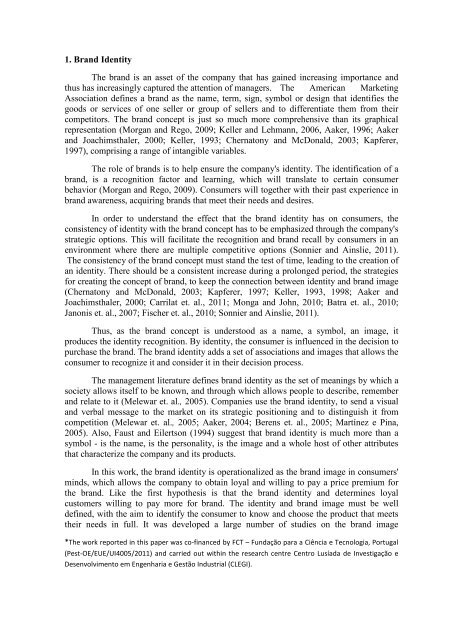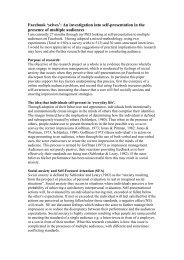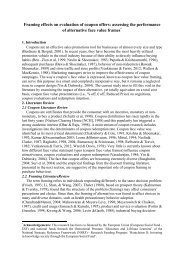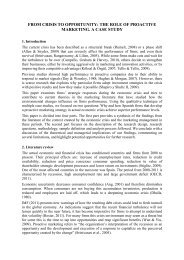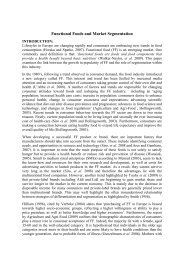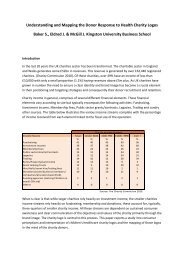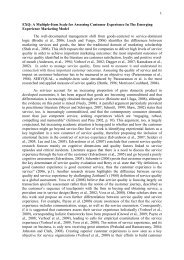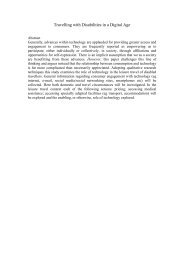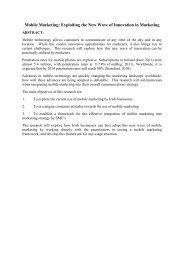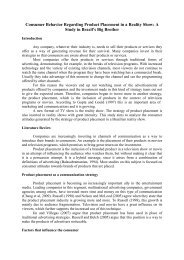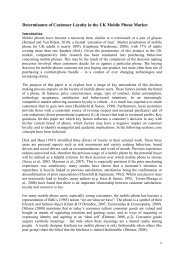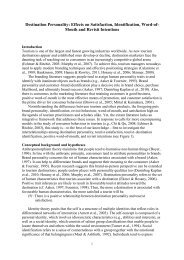The Importance of Brand Identity in Consumer Behavior Abstract
The Importance of Brand Identity in Consumer Behavior Abstract
The Importance of Brand Identity in Consumer Behavior Abstract
Create successful ePaper yourself
Turn your PDF publications into a flip-book with our unique Google optimized e-Paper software.
1. <strong>Brand</strong> <strong>Identity</strong><br />
<strong>The</strong> brand is an asset <strong>of</strong> the company that has ga<strong>in</strong>ed <strong>in</strong>creas<strong>in</strong>g importance and<br />
thus has <strong>in</strong>creas<strong>in</strong>gly captured the attention <strong>of</strong> managers. <strong>The</strong> American Market<strong>in</strong>g<br />
Association def<strong>in</strong>es a brand as the name, term, sign, symbol or design that identifies the<br />
goods or services <strong>of</strong> one seller or group <strong>of</strong> sellers and to differentiate them from their<br />
competitors. <strong>The</strong> brand concept is just so much more comprehensive than its graphical<br />
representation (Morgan and Rego, 2009; Keller and Lehmann, 2006, Aaker, 1996; Aaker<br />
and Joachimsthaler, 2000; Keller, 1993; Chernatony and McDonald, 2003; Kapferer,<br />
1997), compris<strong>in</strong>g a range <strong>of</strong> <strong>in</strong>tangible variables.<br />
<strong>The</strong> role <strong>of</strong> brands is to help ensure the company's identity. <strong>The</strong> identification <strong>of</strong> a<br />
brand, is a recognition factor and learn<strong>in</strong>g, which will translate to certa<strong>in</strong> consumer<br />
behavior (Morgan and Rego, 2009). <strong>Consumer</strong>s will together with their past experience <strong>in</strong><br />
brand awareness, acquir<strong>in</strong>g brands that meet their needs and desires.<br />
In order to understand the effect that the brand identity has on consumers, the<br />
consistency <strong>of</strong> identity with the brand concept has to be emphasized through the company's<br />
strategic options. This will facilitate the recognition and brand recall by consumers <strong>in</strong> an<br />
environment where there are multiple competitive options (Sonnier and A<strong>in</strong>slie, 2011).<br />
<strong>The</strong> consistency <strong>of</strong> the brand concept must stand the test <strong>of</strong> time, lead<strong>in</strong>g to the creation <strong>of</strong><br />
an identity. <strong>The</strong>re should be a consistent <strong>in</strong>crease dur<strong>in</strong>g a prolonged period, the strategies<br />
for creat<strong>in</strong>g the concept <strong>of</strong> brand, to keep the connection between identity and brand image<br />
(Chernatony and McDonald, 2003; Kapferer, 1997; Keller, 1993, 1998; Aaker and<br />
Joachimsthaler, 2000; Carrilat et. al., 2011; Monga and John, 2010; Batra et. al., 2010;<br />
Janonis et. al., 2007; Fischer et. al., 2010; Sonnier and A<strong>in</strong>slie, 2011).<br />
Thus, as the brand concept is understood as a name, a symbol, an image, it<br />
produces the identity recognition. By identity, the consumer is <strong>in</strong>fluenced <strong>in</strong> the decision to<br />
purchase the brand. <strong>The</strong> brand identity adds a set <strong>of</strong> associations and images that allows the<br />
consumer to recognize it and consider it <strong>in</strong> their decision process.<br />
<strong>The</strong> management literature def<strong>in</strong>es brand identity as the set <strong>of</strong> mean<strong>in</strong>gs by which a<br />
society allows itself to be known, and through which allows people to describe, remember<br />
and relate to it (Melewar et. al., 2005). Companies use the brand identity, to send a visual<br />
and verbal message to the market on its strategic position<strong>in</strong>g and to dist<strong>in</strong>guish it from<br />
competition (Melewar et. al., 2005; Aaker, 2004; Berens et. al., 2005; Martínez e P<strong>in</strong>a,<br />
2005). Also, Faust and Eilertson (1994) suggest that brand identity is much more than a<br />
symbol - is the name, is the personality, is the image and a whole host <strong>of</strong> other attributes<br />
that characterize the company and its products.<br />
In this work, the brand identity is operationalized as the brand image <strong>in</strong> consumers'<br />
m<strong>in</strong>ds, which allows the company to obta<strong>in</strong> loyal and will<strong>in</strong>g to pay a price premium for<br />
the brand. Like the first hypothesis is that the brand identity and determ<strong>in</strong>es loyal<br />
customers will<strong>in</strong>g to pay more for brand. <strong>The</strong> identity and brand image must be well<br />
def<strong>in</strong>ed, with the aim to identify the consumer to know and choose the product that meets<br />
their needs <strong>in</strong> full. It was developed a large number <strong>of</strong> studies on the brand image<br />
*<strong>The</strong> work reported <strong>in</strong> this paper was co-f<strong>in</strong>anced by FCT – Fundação para a Ciência e Tecnologia, Portugal<br />
(Pest-OE/EUE/UI4005/2011) and carried out with<strong>in</strong> the research centre Centro Lusíada de Investigação e<br />
Desenvolvimento em Engenharia e Gestão Industrial (CLEGI).


